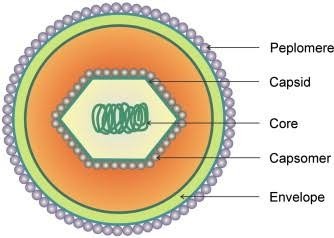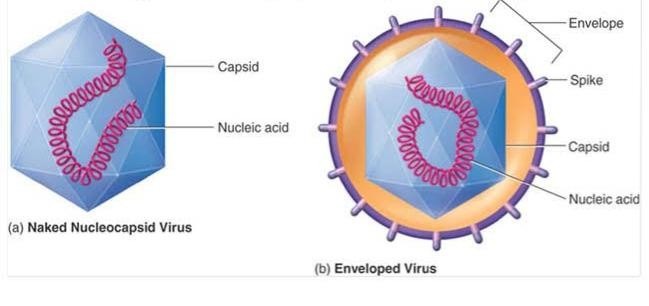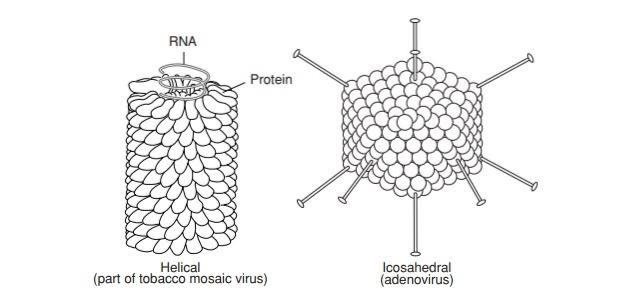Virus: Introduction, Properties and Classifications
Introduction of virus
- Viruses are simple, non-cellular organism.
- Viruses contains one or more molecules of either DNA or RNA include in a coat of protein.
- Viruses are so small that, they can be seen at magnifications provided by electron microscope.
- Viruses are smaller than prokaryotic cells ranging in size from 0.2 to 0.3 micrometres.
- Smallpox virus is largest virus about 200 nm in diameter and Polio Virus is smallest virus about 28 nm in diameter.
- Viruses are incapable of independent growth in artificial media in laboratory.
- The structurally complete mature and fully assembled infectious virus is called the Virion.
- Delivery of DNA or RNA genome of virus or Virion into the host cell, is the main function of virions, so that the genome can be expressed by the host cell .
- Virology is the study of viruses.
General properties
- Viruses are a unique group of infectious agent whose uniqueness resides in their simple, acellular organisation and pattern of reproduction.
Viruses differs from the living cells in three ways:
-
- Their simple, acellular organisation.
- The presence of either DNA or RNA, but not both (like human cells).
- Their inability to reproduce independently and carry out cell divisions.

Viral structure
- Virions are very diverse in structure, differ in size, shape and chemical composition.
- All viruses have a Nucleocapsid consists of a nucleic acid enclosed by a protein coat known as Capsid.
- A protein coat Capsid operate as a defender to the viral genome from nucleases, and at the time of infection attaches the virion to special receptors.

- Capsid (protein coat) is made up of morphological subunits, called Capsomers.
- The proteins that are used to build the capsid are called Protomers.
- The nucleic acid and capsids together forms the Nucleocapsid.
- Enveloped viruses- virions having an envelope.
- Naked viruses- Those lacking an envelope.
- A fringe of glycoprotein, spikes exhibit by enveloped viruses are called Peplomers.
Viral genome
- Smaller in size.
- Bacteriophage G, largest viral genome i.e. 670 Kbs.
- The virus genome could also be consisting of DNA or RNA, which can be single stranded or double stranded, linear or circular.
- Antisense (negative sense, minus sense).
Shape or symmetry
- All viruses have a nucleocapsid structure.
- The symmetry refers to the way in which the capsomers are arranged in the virus capsid.
- Symmetry maybe:
-
- Icosahedral (spherical shape).
- Helical (rod-shape).
Helical symmetry
- It is Shaped like Hollow tubes with protein walls.
- A typical virus with helical symmetry is TMV (tobacco mosaic virus).
- It is in nucleocapsids of many filamentous and pleomorphic viruses.
- The Capsid encloses an RNA genome, which is wound in a spiral and lies within a groove formed by Capsomers.
Icosahedral symmetry
- Characteristics of many spherical viruses.
- It is regular polyhedron with 20 equilateral triangular faces and 12 vertices.
- Complex structure have capsid symmetry that is neither purely icosahedral nor helical.
- Example:- T4 virus.

Classifications
Viruses are classified into different taxonomic group based on:
- Their host cell.
- Virion structure and composition
- Mode of reproduction
- Nature of disease caused
- Genetic material
- Number of strands
On the basis of host, viruses are:
- Animal virus.
- Plant virus.
- Bacterial virus.
- Animal viruses- They live insides the animal cells. Example-smallpox virus, influenza virus, poliovirus and herpes virus.
- Plant viruses- They are present inside plant cells and genetic material is RNA.
- Example- Tobacco mosaic virus (TMV), Potato virus (PV), Beet yellow virus(BYV).
- Bacterial viruses– They are parasite in bacterial cells and known as Bacteriophages.
On the basis of genetic material, viruses are:
- DNA virus
- RNA virus
- DNA – RNA virus
- DNA virus- The genetic material of these viruses are DNA double stranded DNA.
- Example: Bacteriophages T2, T4, T6 and lambda, adenovirus, herpes virus.
- Single stranded DNA.
- Example: M13 and Bacteriophages phi × 174.
- RNA viruses Genetic material is RNA.
- Double stranded RNA:
- Example– Tumor virus and rice dwarf virus (plants), Retrovirus (animals).
- Single stranded RNA:
- Example– TMV, Influenza.
- DNA RNA viruses –
- Genetic material is alternatively DNA or RNA.
- Example– RNA – Tumor virus called Leukovirus or Rousvirus.
Reference and Sources
- 1% – https://www.sciencedirect.com/science/article/pii/B9780123946263000028
- 2% – https://www.researchgate.net/publication/50410801_Structure_and_Classification_of_Viruses
- 1% – https://quizlet.com/136175210/microbiology-pathology-flash-cards/
- 1% – https://www.sciencedirect.com/topics/biochemistry-genetics-and-molecular-biology/capsid
- 2% – https://universityexpressmonthly.blogspot.com/
- 1% – https://www.ncbi.nlm.nih.gov/books/NBK8174/?report=classic
- 1% – https://wenku.baidu.com/view/3373872a647d27284b7351f8
- 2% – https://www.yourarticlelibrary.com/biology/prokaryotic-cells-its-characteristics-and-types-biology/4949
Also Read
- Virus: Structure, Types and Function
- Influenza (Flu): Introduction, Types, Antiviral Drugs and immunization
- Classification of viruses on the basis of genome
- Proteins: Definition, Roles, Functions and Structure
